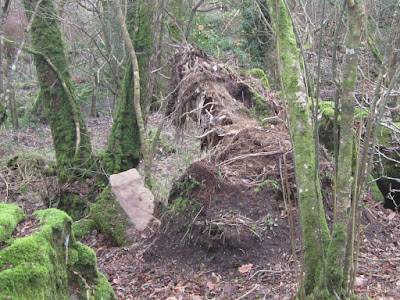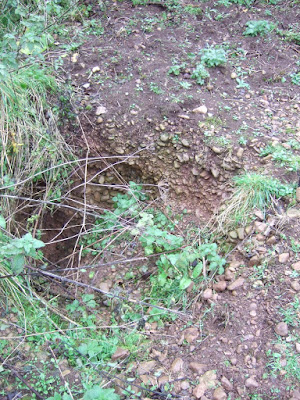I have done an earlier post on this -- based largely on some of the recent glacial modelling:
https://brian-mountainman.blogspot.com/2018/10/was-there-proglacial-lake-on-somerset.html
The idea of a large lake covering the Somerset Levels has been mostly ridiculed in recent years, but I have been forced to think about it again by the evidence from Bleadon Hill, which suggests a terrace that might be a kame terrace or glacial lake shoreline deposit at around 82m OD.
https://brian-mountainman.blogspot.com/2018/12/the-glaciofluvial-gravel-terrace-at.html
When I looked around the Mendips with Alex back in October, we visited two rather interesting sites -- one at Blagdon Coombe, and the other at Crook Peak, at the western end of the Mendips.
At the former site, at the western end of what must surely be a winding glaciofluvial meltwater channel, there is a broken up rock face of Carboniferous Limestone in the woods opposite Rickford Church, displaying some rather interesting features.
The exposed limestone cliff faces are in the woods, on the south side of the valley, where it opens out to the west -- more or less where the head of the arrow is located.
There appears to be a horizontal "precipitation layer" made of calcium carbonate on the vertical rock surface. Maybe there are two layers? Alex has made several visits to the site, and will enlighten us. The only obvious explanation for these layers is that they represent a water surface. But was this the surface of a lake? And if so, when was it present, and for how long did it survive? The only other explanation is that the water was ponded within a cave which has subsequently lost its outer flank by vast slabs of rock tumbling down into the valley. And there does not seem to be any sign in the landscape that this has happened. If the concretions can be dated, that would solve the problem.......
These are the slight ridges of calcium carbonate cement, about two-thirds of the way down from the top of the photo. They appear to be precipitation features, but they might just be solutional, etched into an older crust on the rock surface.
I'm not sure whether Alex has done any accurate surveying here, but it looks to me from the maps that the altitude of this surface or "level" is around 82m. Sounds familiar?
Moving swiftly westwards to Crook Peak, there is another interesting exposure of Carboniferous Limestone on the hillside above the car-parking area on the minor road between xxxx
There are a number of extensive exposures of slabs with smooth undulating rock surfaces which I thought at first were glacially moulded surfaces. I have revised my opinion on that, and now think that the surfaces expose primary mega-ripples and other sedimentary surface features on bedding planes. These planes coincide more or less with the slope of the ground surface, and here and there we can see the "steps" along which overlying strata are -- bit by bit -- breaking off, with the debris then sliding downslope and accumulating in hollows are piling up against areas of well-anchored vegetation. We can see a bedding plane and a step in this photo:
I don't dismiss some role for glacial erosion here, and ice may have had a "cleaning up" role. But what I find really interesting is what happens upslope, where the limestone surface is more fractured, with a greater cover of algae and other plants, and with more rock debris littering the surface:
I'm not sure what is going on here, since we didn't have much time for detailed observations or measurements, but in my mind I have memories from Greenland, Iceland and Antarctica, where I spent much time in the past searching for marine limits and "washing lines" created by wave sapping -- in which debris beneath the line was carried down into deeper water, and debris above it was left in place. In Scandinavia hills with debris caps on them and water-washed lower slopes are called "kalottberg hills."
And what is the altitude of this apparent washing line? As you might have guessed -- around 82m. So we have three different localities on the flanks of the Mendips with apparent traces of a water-level at around 82m -- can that really be a coincidence?
-----------------------
We have talked on many previous occasions about the significance of Mendip, and the apparent signs of meltwater activity on a rather grand scale:
https://brian-mountainman.blogspot.com/2018/10/on-significance-of-mendip-for.html
https://brian-mountainman.blogspot.com/2011/08/strange-valleys-of-mendips.html
I still think there may have been a small ice cap on the hills at some stage -- or maybe more than one stage -- and that great volumes of meltwater have had a substantial effect on the landscape. Some of that meltwater might have been flowing in subglacial channels, as many authors have suggested in the past.
Then we come to Lake Maw. It was suggested by Maw in 1864 that there might have been a large pro-glacial lake in the inner part of the BristolmChannel at sone stage during the Ice Age -- and this idea was developed by Frank Mitchell in 1960 -- in one of the papers that had a great influence on my own work. Later on Prof Nick Stephens thought that there might have been a great body of water trapped on the Somerset Levels, providing an explanation for some of the deeper gravel deposits beneath the peat and also explaining the substantial terraces of gravel that exist to the south, beyond the Chard Gap and in the valley of the Axe. These terrace gravels have been examined in detail at Chard Junction, Broom and elsewhere. The deep valley in Chard Gap was interpreted by Stephens as a spillway for pro-glacial lake. Other authors have dismissed Mitchell's ideas on the basis that there are no independent signs of this vast glacial lake -- but this is perhaps not surprising, given that most of the Somerset Plain is today deeply buried beneath peat layers. Also, those who dismiss the pro-glacial lake hypothesis have failed to adequately explain where these vast thicknesses (in places more than 20m thick) of sands and gravels in the Axe Valley have come from.........

The extent of Lake Maw as defined by Mitchell in 1960. There is a fundamental illogicality in not extending the lake into the Somerset Levels, since there can have neen no obstacle to the water flooding eastwards.....
A segment of a larger map from Stephens (in 1970). There is much of interest here, but if we concentrate on Lake Maw, we see it as much more extensive, flooding the whole of the Somerset Plain and spilling southwards via the Chard Gap.
The lowest surface altitude in the Chard Gap today is around 90m, but I have no idea whether the town and the countryside immediately to the east of it are underlain by thicknesses of gravel or other deposits. The geology maps are not particularly helpful, showing colluvium, alluvium and head, with gravel terraces occurring a few kilometres downstream, on the flanks of the main Axe Valley. The bedrock altitude in the highest part of the Chard Gap is what matters -- and I might hazard a guess that it is somewhere around 82m.........
So are we about to bring Lake Maw back into fashion? I hesitate to say that, but there is certainly something interesting going on here. Watch this space.........




































